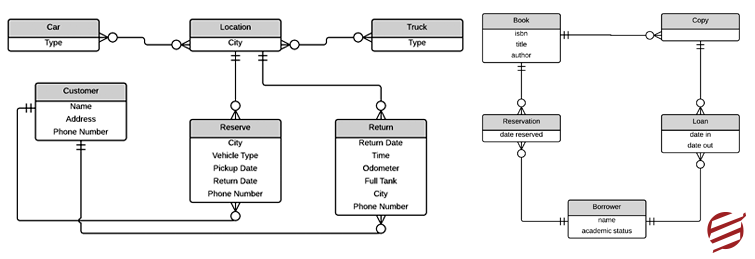Question:
Identify all the essential concepts in the library database case study described below. In particular, identify the abstractions of classification (entity types and relationship types), aggregation, identification, and specialization/generalization. Specify (min, max) cardinality constraints whenever possible. List details that will affect the eventual design but have no bearing on the conceptual design. List the semantic conditions separately.
The Georgia Tech Library (GTL) has approximately 16,000 members, 100,000 titles, and 250,000 volumes (an average of 2.5 copies per book). About 10 percent of the volumes are out on loan at any time. The librarians ensure that the members of the reader want to borrow available when they want to borrow them. In addition, librarians must know how many copies of each book are in a library or out on loan at any time.
A catalog of books is available online that lists books by author, title, and subject area. For each title in the library, a book description exists in the catalog that ranges from one sentence to several pages. The reference librarians want to be able to access this description when members request information about a book. The staff includes the chief librarian, departmental associate librarians, reference librarians, check-out staff, and library assistants.
ER Diagram Of A Library Database
Books are available to lend for 21 days. Members are allowed to have only five books out at a time. Members usually return books within three to four weeks. Most members know they have one week of grace before a notice reaches them, so they try to return books before the grace period ends. About 5 percent of the members need reminders to return books. Others return overdue books within a month of the due date. Approximately 5 percent of outstanding books are either kept or never returned. The library's most active members are those who borrow books at least ten times during the year. The top 1 percent of the membership does 15 percent, and the top 10 percent does 40 percent of the borrowing. About 20 percent of the readers' names stay only to increase the database.
To become a library member, applicants fill out a form including their SSN, campus, mailing addresses, and phone numbers. After selection, librarians issue a numbered, machine-readable card with the member's photo. This card has four years' validity. A month before a card expires, a notice goes to a member for renewal. Interestingly, professors at the institute come in a group of automatic members. When new faculty members join the institute, librarians browse their information from the employee records and issue a library card to their campus address. Professors have permission to lend books for three-month intervals with a two-week grace period. In addition, they receive renewal notices right at their campus addresses.
Reference books, rare books, and maps are not on the list of issuable books. Plus, librarians differentiate between books to be lent and not. In addition, the librarians have a list of specific books they are interested in but need help acquiring, such as rare or out-of-print books and lost or destroyed books needing replacement. A system keeps track of all such books. Titles of books are inappropriate for identification as several novels may have nearly the same title. Hence, every book has an International Standard Book Number (ISBN), a unique international code as an identity. For instance, two books with the same title can have different ISBNs in different languages or have other bindings (hardcover or softcover). Also, editions of the same book have different ISBNs.
The proposed database system must keep track of the members, the books, the catalog, and the borrowing activity.
Solution: Students can browse samples, study material, and academic resources for database assignments at our website. Chat with the assignment adviser to get answers to similar problems and customized solutions for your specific need.



